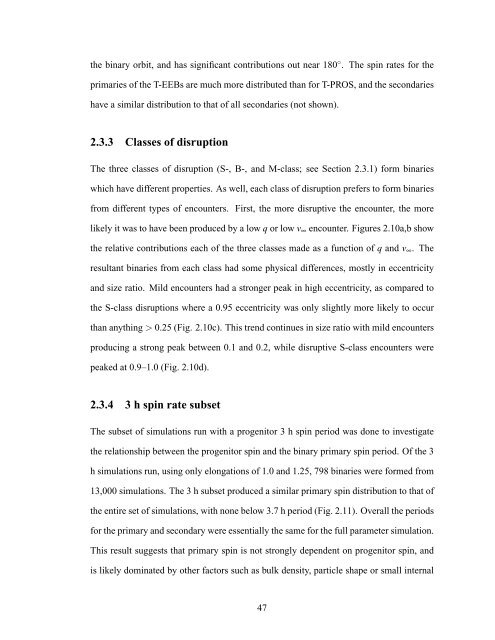Forming Binary Near-Earth Asteroids From Tidal Disruptions
Forming Binary Near-Earth Asteroids From Tidal Disruptions
Forming Binary Near-Earth Asteroids From Tidal Disruptions
Create successful ePaper yourself
Turn your PDF publications into a flip-book with our unique Google optimized e-Paper software.
the binary orbit, and has significant contributions out near 180 ◦ . The spin rates for theprimaries of the T-EEBs are much more distributed than for T-PROS, and the secondarieshave a similar distribution to that of all secondaries (not shown).2.3.3 Classes of disruptionThe three classes of disruption (S-, B-, and M-class; see Section 2.3.1) form binarieswhich have different properties. As well, each class of disruption prefers to form binariesfrom different types of encounters. First, the more disruptive the encounter, the morelikely it was to have been produced by a low q or low v ∞ encounter. Figures 2.10a,b showthe relative contributions each of the three classes made as a function of q and v ∞ . Theresultant binaries from each class had some physical differences, mostly in eccentricityand size ratio. Mild encounters had a stronger peak in high eccentricity, as compared tothe S-class disruptions where a 0.95 eccentricity was only slightly more likely to occurthan anything > 0.25 (Fig. 2.10c). This trend continues in size ratio with mild encountersproducing a strong peak between 0.1 and 0.2, while disruptive S-class encounters werepeaked at 0.9–1.0 (Fig. 2.10d).2.3.4 3 h spin rate subsetThe subset of simulations run with a progenitor 3 h spin period was done to investigatethe relationship between the progenitor spin and the binary primary spin period. Of the 3h simulations run, using only elongations of 1.0 and 1.25, 798 binaries were formed from13,000 simulations. The 3 h subset produced a similar primary spin distribution to that ofthe entire set of simulations, with none below 3.7 h period (Fig. 2.11). Overall the periodsfor the primary and secondary were essentially the same for the full parameter simulation.This result suggests that primary spin is not strongly dependent on progenitor spin, andis likely dominated by other factors such as bulk density, particle shape or small internal47












